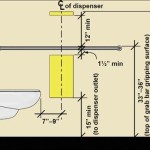How To Measure For A New Bathroom Sink
Selecting the right bathroom sink can significantly impact both the functionality and aesthetic appeal of a bathroom. Before browsing catalogs or visiting showrooms, accurate measurements are essential. Taking precise measurements ensures the chosen sink will fit the available space, connect properly to existing plumbing, and complement the overall design of the bathroom. This article provides a comprehensive guide on how to measure for a new bathroom sink, covering various sink types and essential considerations.
The process of measuring for a new bathroom sink involves several steps, each contributing to ensuring a correct fit and preventing costly mistakes. It's crucial to understand the different types of sinks available, the specific dimensions to consider for each type, and the necessary tools and techniques for accurate measurement. Ignoring even one of these aspects can lead to choosing a sink that is either too small, too large, or incompatible with the existing plumbing setup.
Before beginning, gather the necessary tools. A measuring tape (preferably a metal one for accuracy), a pencil or pen, paper for recording measurements, and a level are essential. A flashlight may also be helpful for inspecting plumbing connections under the existing sink. If replacing an existing sink, a camera can be used to document the current setup, which may be useful during the installation process.
Determining the Existing Sink Type and Space Constraints
Identifying the existing sink type is the first step. Common types include: vanity sinks (drop-in, undermount, vessel), pedestal sinks, wall-mounted sinks, and console sinks. Each type has unique measurement requirements. Vanity sinks, for example, require measuring the interior dimensions of the vanity cabinet, while pedestal and wall-mounted sinks require measuring the available wall space and the location of plumbing connections.
Vanity sinks are designed to be installed within a cabinet. Drop-in sinks are installed from above, resting on the countertop. Undermount sinks are installed from below, creating a seamless transition between the countertop and the sink. Vessel sinks sit on top of the countertop, resembling a bowl. To measure for a vanity sink, the interior dimensions of the vanity cabinet, including width, depth, and height, are crucial. Also, measure the distance from the cabinet floor to the drainpipe to ensure adequate clearance for the sink's drain assembly.
Pedestal sinks consist of a basin supported by a pedestal base. Wall-mounted sinks are attached directly to the wall, without a cabinet or pedestal. For these types, the available wall space is the primary consideration. Measure the width and height of the desired installation area, paying attention to any obstructions such as pipes or electrical outlets. The location of existing plumbing connections (supply lines and drainpipe) is also critical. The new sink must be compatible with these existing connections, or modifications may be required.
Console sinks combine features of both vanity and wall-mounted sinks, typically featuring a basin supported by legs and sometimes a small shelf. Measuring for a console sink involves considering both the available wall space and the floor space. Measure the width and height of the wall space, as well as the distance from the wall to any potential obstructions on the floor. The location of plumbing connections must also be considered, as with pedestal and wall-mounted sinks.
Once the existing sink type is identified, assess the overall space constraints in the bathroom. Consider the placement of other fixtures, such as the toilet and shower or bathtub, to ensure adequate clearance for movement and use. Also, consider the placement of doors and windows, as these can further limit the available space for a new sink. Documenting these constraints with accurate measurements is crucial for selecting a sink that fits comfortably within the bathroom layout.
It's also important to consider the height of the sink. Standard bathroom sink height is typically between 30 and 36 inches, but this can vary depending on individual preferences and needs. If the bathroom is used by children or individuals with mobility issues, a lower sink height may be more appropriate. Measure the desired height of the new sink and consider this measurement when choosing a sink type and size.
Taking Precise Sink Measurements
After identifying the sink type and space constraints, the next step is to take precise measurements. For vanity sinks, the interior dimensions of the vanity cabinet are critical. For pedestal and wall-mounted sinks, the available wall space and the location of plumbing connections are paramount. For console sinks, both wall and floor space must be considered.
For vanity sinks, measure the interior width, depth, and height of the vanity cabinet. The width and depth measurements will determine the maximum size of the sink that can be installed. The height measurement will determine the amount of clearance available for the sink's drain assembly. When measuring the width and depth, measure both at the top and bottom of the cabinet, as the dimensions may vary slightly. Use the smaller of the two measurements to ensure a proper fit. For drop-in sinks, also measure the cutout size in the countertop. This measurement is crucial for ensuring that the new sink fits properly into the existing opening.
For undermount sinks, the countertop cutout size is even more critical. Undermount sinks are typically installed with a slight overhang, so the cutout must be precisely sized to accommodate the sink's dimensions. Consult the sink manufacturer's specifications for the recommended cutout size. It's also important to consider the thickness of the countertop when choosing an undermount sink. The sink must be able to be securely attached to the underside of the countertop.
For pedestal and wall-mounted sinks, measure the available wall space, including the width and height. Pay attention to any obstructions, such as pipes or electrical outlets. The location of existing plumbing connections is also critical. Measure the distance from the floor to the drainpipe and the distance between the supply lines. The new sink must be compatible with these existing connections, or modifications may be required. If modifications are necessary, it's best to consult with a qualified plumber before proceeding.
For console sinks, measure both the available wall space and the floor space. Measure the width and height of the wall space, as well as the distance from the wall to any potential obstructions on the floor. The location of plumbing connections must also be considered. As with pedestal and wall-mounted sinks, the new sink must be compatible with the existing plumbing connections.
When taking measurements, ensure the measuring tape is level and straight. Avoid bending or twisting the tape, as this can lead to inaccurate measurements. Record all measurements carefully, noting the units of measurement (inches or centimeters). Double-check all measurements to ensure accuracy. It's also helpful to take photographs of the existing sink and plumbing setup. These photographs can be useful when selecting a new sink and during the installation process.
Considering Plumbing and Installation Requirements
Beyond the physical dimensions of the sink and the available space, plumbing and installation requirements are also critical considerations. The location and type of existing plumbing connections (supply lines and drainpipe) must be compatible with the new sink. The installation process may also require specialized tools or skills.
The placement of the drainpipe is a primary concern. The new sink must have a drain outlet that aligns with the existing drainpipe. If the drainpipe is located too high or too low, modifications may be required. These modifications can be costly and time-consuming, so it's best to choose a sink that is compatible with the existing plumbing setup.
The type of drain assembly is another important consideration. Common types include pop-up drains, lift-and-turn drains, and grid drains. Each type has its own advantages and disadvantages. Pop-up drains are easy to use and provide a tight seal, but they can be prone to clogging. Lift-and-turn drains are more durable and less likely to clog, but they can be more difficult to use. Grid drains are simple and inexpensive, but they do not provide a tight seal.
The placement of the supply lines is also critical. The new sink must have faucet holes that align with the existing supply lines. If the faucet holes are located too far apart or too close together, modifications may be required. It's also important to consider the type of faucet that will be used with the new sink. Some faucets require three holes (for hot water, cold water, and a spout), while others require only one hole (for a single-handle faucet). Ensure that the sink has the appropriate number of faucet holes for the chosen faucet.
The installation process for a new bathroom sink can vary depending on the sink type and the complexity of the plumbing connections. Drop-in sinks are typically the easiest to install, while undermount sinks require more precision and skill. Pedestal and wall-mounted sinks can be challenging to install, as they require secure attachment to the wall. If uncertain about the installation process, it's best to consult with a qualified plumber. A professional plumber can ensure that the sink is properly installed and that all plumbing connections are secure.
Finally, consider any building codes or regulations that may apply to the installation of a new bathroom sink. Some jurisdictions require permits for plumbing work. Ensure that all work is performed in compliance with local codes and regulations. This will help to avoid costly fines or penalties.
By carefully considering these factors, it is possible to accurately measure for a new bathroom sink and ensure a successful installation. Taking the time to plan and measure properly is an investment that will save time, money, and frustration in the long run.
How To Measure For A Bathroom Basin Or Sink Victoriaplum Com

Bathroom Layout Measurement Advice Victoriaplum Com More

How To Measure A Basin

How To Choose The Right Vanity For Your Bathroom Riverbend Home
How To Measure For A Bathroom Basin Or Sink Victoriaplum Com

3 Ways To Measure A Kitchen Sink Wikihow

How To Measure A Bathroom Sink Size Lavatory For Replacement

Bathroom Measurement Guide These Are The Measurements You Need To Know

Standard Bathroom Sink Dimensions With Photos Upgradedhome Com

Bathroom And Restroom Measurements Standards Guide
Related Posts







